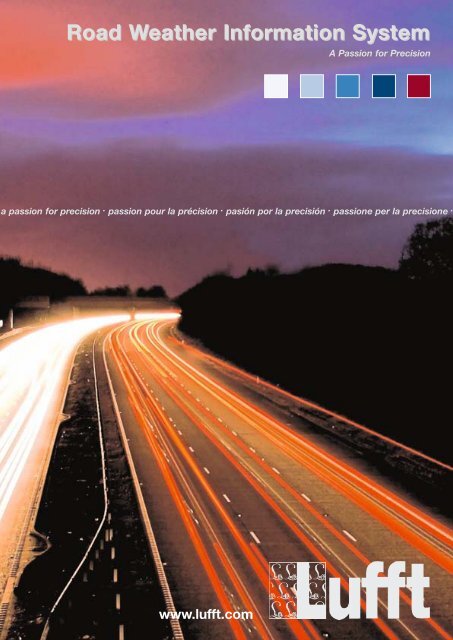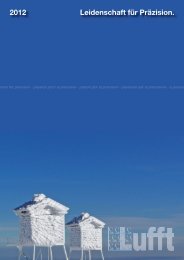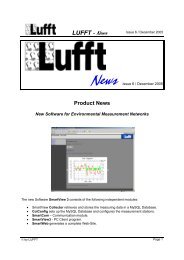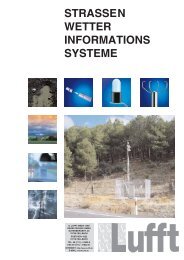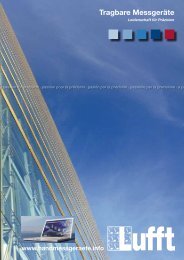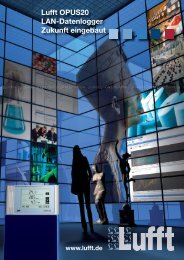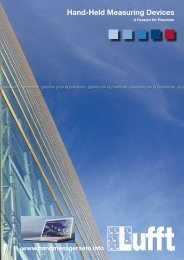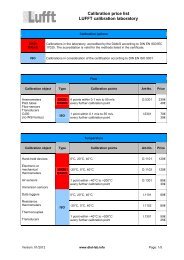Road Weather Information System - Lufft GmbH
Road Weather Information System - Lufft GmbH
Road Weather Information System - Lufft GmbH
Create successful ePaper yourself
Turn your PDF publications into a flip-book with our unique Google optimized e-Paper software.
<strong>Road</strong> <strong>Weather</strong> W<br />
<strong>Information</strong> <strong>System</strong><br />
A Passion for Precision<br />
a passion for precision . passion pour la précision . pasión por la precisión . passione per la precisione .<br />
www.lufft.com
<strong>Road</strong> <strong>Weather</strong><br />
<strong>Information</strong> <strong>System</strong><br />
Thermal Mapping<br />
Nowcasting /<br />
Forecasting<br />
Real-Time<br />
<strong>Weather</strong><br />
Database<br />
+Pictures<br />
XFCD<br />
Mobile Data<br />
Sources<br />
MDSS<br />
Archive<br />
Warnings<br />
Alert Messages<br />
Wind / Fog /<br />
Ice / Water<br />
Traffic<br />
Control<br />
Alarms<br />
Actions<br />
Tables / Charts<br />
Maps / Groups<br />
Pictures<br />
Standard / Customized<br />
Guiding<br />
Travel Time<br />
Calculation<br />
www.lufft.com<br />
Fog Warning<br />
Wind Alarms<br />
Aquaplaning
Remote <strong>Weather</strong> Station<br />
R 2 S<br />
precipitation type and intensity<br />
with Protection shield<br />
Temperature/ rel. Humidity<br />
with Radiation shield<br />
Wind direction / Wind speed<br />
Visibility sensor<br />
<strong>Road</strong> surface temperature / <strong>Road</strong> conditions<br />
UMB<br />
www.lufft.com
Static calculation<br />
pole:<br />
Every pole needs to be certified to proof its stability with all<br />
mounted sensors, according to European norms. Most of the<br />
parts are V4A (material grade) and corrosion-free. This foldover<br />
pole permits a one man maintenance operation. All<br />
cables are hidden in order to avoid vandalism.<br />
www.lufft.com
pole<br />
hidden cables<br />
4.5 m height<br />
www.lufft.com
What do we measure<br />
(Sensors)<br />
Intelligent, an "all-in-one" instrument<br />
for atmospheric conditions<br />
Innovative measuring principle:<br />
R 2 S)<br />
microwave doppler radar.<br />
Type of Precipitation<br />
(rain, snow)<br />
Precipitation intensity<br />
(mm/H)<br />
Measuring wind speed/direction<br />
by means of an ultrasonic sensor.<br />
Precise measurement without<br />
mechanical moving parts.<br />
Air pressure<br />
Air temperature & relative<br />
humidity<br />
aspirated ventilation shield<br />
Power supply and<br />
communication in one cable.<br />
RS485 digital communication with<br />
open ASCII or UMB protocol<br />
(SDI12 in preparation)<br />
up to 1200 meters.<br />
www.lufft.com
IRS31-UMB - Intelligent road sensor<br />
Passive road sensor IRS31 is<br />
flush-mounted in the road.<br />
The two part housing design<br />
allows the combined<br />
sensor/electronics unit to be<br />
removed for maintenance or<br />
calibration at any time.<br />
The following variables are<br />
recorded:<br />
- <strong>Road</strong> surface temperature<br />
- Water film height up to 4 mm<br />
- Freezing temperature for<br />
different<br />
de-icing materials<br />
- <strong>Road</strong> condition<br />
(dry/damp/wet/ice or<br />
snow/residual salt/freezing<br />
rain)<br />
Optional:<br />
- 2 additional depth<br />
temperatures,<br />
e.g. at 5 cm and 30 cm<br />
Technical Data<br />
Order No.<br />
IRS31-UMB Intelligent road sensor 8510.U050<br />
Measuring range temperatures<br />
-30°C...+70°C<br />
Accuracy temperatures<br />
+/- 0,2°C (-10°C...+10°C), otherwise +/-0,5°C<br />
Measuring range water film height<br />
0...4mm<br />
Accuracy water film height<br />
+/- 0,1mm +20% of measurement value<br />
Freezing temperature graphs<br />
1...10 (Standard: NaCl, CaCl, MgCl)<br />
Measuring range freezing temperature<br />
-20°C…0°C<br />
Accuracy freezing temperature<br />
+/-1°C für t>-10°C<br />
<strong>Road</strong> conditions<br />
Dry/damp/wet/ice or<br />
snow/residual salt/freezing rain<br />
Dimensions<br />
Ø 120mm, installation height 50mm<br />
Weight<br />
approx. 800g<br />
Cable length<br />
50m<br />
Protection type IP 68<br />
IRS31-UMB with other cable lengths or additional depth temperature sensors:<br />
2 depth temperature sensors, 50 m cable 8510.U052<br />
100 m cable 8510.U100<br />
2 depth temperature sensors, 100 m cable 8510.U102<br />
Housing road sensor without ext. temperature 8510.G050<br />
Housing road sensor 1 ext. temperature, 50m 8510.G051<br />
Housing road sensor 2 ext. temperature, 50m 8510.G052<br />
Housing road sensor without ext. temperature 8510.G100<br />
Housing road sensor 1 ext. temperature, 100m 8510.G101<br />
Housing road sensor 2 ext. temperature, 100m 8510.G102<br />
Accessories<br />
Order No.<br />
UMB interface converter ISOCON<br />
8160.UISO<br />
<strong>Road</strong> sensor cover (electronics)<br />
8510.DEC<br />
Surge protection<br />
8379.USP<br />
The sensors are addressable and<br />
can therefore be networked.<br />
The measurement data are<br />
available for further processing in<br />
the form of a standard protocol<br />
(<strong>Lufft</strong> UMB protocol).<br />
www.lufft.com
ARS31-UMB - Intelligent road sensor<br />
The active ARS31 sensor<br />
is installed flush with the<br />
road/runway surface and<br />
calculates the freezing<br />
temperature by means of<br />
active cooling and heating<br />
of the sensor surface.<br />
The freezing temperature<br />
measurement is independent<br />
of mixture.<br />
The two-section housing design<br />
allows the combined sensor/<br />
electronics unit to be removed<br />
for maintenance purposes at<br />
any time, in just a few minutes.<br />
In conjunction with interface<br />
converter 8160.UISO,<br />
the sensor can be built into<br />
new and existing UMB networks.<br />
Technical Data<br />
Order No.<br />
ARS31-UMB Intelligent road sensor 8610.U050<br />
Dimensions<br />
Ø 120mm, height 50mm<br />
Weight<br />
Approx. 900g<br />
Storage temperature<br />
-30...70°C<br />
Protection type<br />
IP68<br />
Power supply<br />
9...36V VDC<br />
Connector CAGE CLAMP, WAGO (cross-section -15 °C, or<br />
±1,5°C RMSE for Tg < -15 °C<br />
Resolution 0.1<br />
Accessories<br />
Order No.<br />
UMB Interface converter ISOCON<br />
8160.UISO<br />
Spare part cap ARS31-UMB<br />
8610.DEC<br />
Surge Protector UMB<br />
8379.USP<br />
Passive sensor IRS31 and<br />
active sensor ARS31 can be<br />
combined without difficulty,<br />
in fact this is recommended.<br />
The sensors are addressable<br />
and hence can be networked.<br />
www.lufft.com
FAQs<br />
1. Which is the difference between passive and active pavement<br />
sensors<br />
The active sensor uses an integrated PELTIER element for the heating and<br />
cooling process. In case of wet conditions (existing water film) and if the road<br />
surface temperature is less than 5°C, the measuring cycle will be started. One<br />
cycle lasts 20 minutes. The cooling procedure stopps once the freeze point<br />
temperature has been reached. The cooling time depends on water film level<br />
and concentration of de-icing chemicals. After cooling, the heating procedure<br />
is being re-activated.<br />
2. Why is it necessary to use a passive pavement sensor in conjunction<br />
with an active sensor<br />
Since the active sensor has a cooling and heating cycle, the road conditions<br />
are altered. This leads to condensation and pavement temperature changes.<br />
This is the reason the active sensor will ONLY measure freeze point temperature.<br />
All other road measurements such as road surface temperature, depth<br />
temperature, water-film and road conditions are reported by passive sensors.<br />
3. Why do so many networks use passive sensors only<br />
As long as only one de-icing chemical, such as NaCl or MgCl is applied, a<br />
state-of-the-art passive sensor will measure the conductivity, "salt in water"<br />
and calculates the freeze point temperature. A prerequisite for an accurate<br />
result is the precise measurement of the water film.<br />
4. Why is the water film thickness important information for winter road<br />
maintenance operations<br />
The freeze point temperature depends on concentration of de-icing chemical<br />
AND the existing water film thickness. The higher the water film, the more<br />
chemical is necessary. Vice versa, in case of a sloping road and a very thin<br />
water layer, there is a risk to “over-salting” and to exceed the so called<br />
EUTECTICAL POINT.<br />
5. What are the main benefits of non-invasive road condition sensors<br />
The non-invasive sensor is not part of the pavement and is easily accessible<br />
in case of repair and maintenance/calibration. Both, surface temperature and<br />
road conditions can be measured. A disadvantage is in that the freeze temperature<br />
itself cannot be measured.The water film measurement is not nearly as<br />
precise as the measurement of an embedded pavement sensor.<br />
6. Is it feasible to design a <strong>Road</strong> <strong>Weather</strong> Network based on different<br />
road sensor technologies (active/passive/non-invasive)<br />
Networks of the future will be modular, open in concept and extendable.<br />
Where ever possible, embedded pavement sensors will be deployed to provide<br />
all data a particular application In case of very thin water layers (busy highways),<br />
an active sensor will determine the precise freeze temperature.<br />
Locations (bridges) where in-pavement sensors can not be installed,<br />
a non-invasive senor is the best choice to deliver road condition information.<br />
7. Are regular sensor calibrations recommended<br />
Due to the replaceable electronics of pavement sensors, a calibration cycle of<br />
three years is recommended, in spite of the available long-term stable sensor<br />
elements with minimal drift.<br />
Replacement sensors can be installed within minutes, allowing for minimal<br />
down-time of operation as well as lane closures. Sensors are to be sent to a<br />
qualified laboratory for inspection/re-calibration.<br />
www.lufft.com
LUFFT Mess- und Seite/Page: 1/2<br />
Regeltechnik <strong>GmbH</strong><br />
Herstellerprüfzertifikat M nach DIN 55350 -18-4.2.2<br />
Manufacturer test certificate M according to DIN 55350 -18-4.2.2<br />
Gegenstand<br />
Object<br />
Sensornummer<br />
Sensor number<br />
Hersteller<br />
Manufacturer<br />
IRS21<br />
1234<br />
LUFFT Mess - und Regeltechnik <strong>GmbH</strong><br />
Gutenbergstraße 20<br />
D-70736 Fellbach<br />
Temperaturmessung / Temperature measurement<br />
Prüfpunkt<br />
Test point<br />
Fahrbahnoberflächentemperatur<br />
<strong>Road</strong> surface temperature<br />
Tiefentemperatur 1<br />
Temperature under ground 1<br />
Tiefentemperatur 2<br />
Temperature under ground 2<br />
Prüfbedingung<br />
Test c onditions<br />
Temperatur = 0,0°C ±0,1°C<br />
Temperature = 0,0°C ±0,1°C<br />
Temperatur = 0,0°C ±0,1°C<br />
Temperature = 0,0°C ±0,1°C<br />
Temperatur = 0,0°C ±0,1°C<br />
Temperature = 0,0°C ±0,1°C<br />
Bestanden<br />
Passed<br />
Ja Nein<br />
Yes No<br />
X<br />
X<br />
X<br />
Temperatursensor / Temperature sensor<br />
Prüfpunkt<br />
Test point<br />
Fahrbahnoberflächensensor<br />
<strong>Road</strong> surface sensor<br />
Tiefentemperatursensor 1<br />
Temperature sensor under ground 1<br />
Tiefentemperatursensor 2<br />
Temperature sensor under ground 2<br />
Prüfbedingung<br />
Test conditions<br />
Temperatur = 0,0°C ±0,1°C<br />
Temperature = 0,0°C ±0,1°C<br />
Temperatur = 0,0°C ±0,1°C<br />
Temperature = 0,0°C ±0,1°C<br />
Temperatur = 0,0°C ±0,1°C<br />
Temperature = 0,0°C ±0,1°C<br />
Bestanden<br />
Passed<br />
Ja Nein<br />
Yes No<br />
X<br />
X<br />
X<br />
Dieses Prüfzertifikat darf nur vollständig und unverändert weiterverbreitet werden. Auszüge oder Änderungen<br />
bedürfen der Genehmigung des Ausstellers. Prüfzertifikate ohne Unterschrift und Stempel haben keine Gültigkeit.<br />
This test certificate may not be reproduced other than in full except with the permission of the exhibiting company.<br />
Test certificates without signature and seal are not valid.<br />
Stempel<br />
Seal<br />
Datum<br />
Date<br />
Qualitätssicherung<br />
Quality control<br />
Bearbeiter<br />
Person in charge
LUFFT Mess- und Seite/Page: 2/2<br />
Regeltechnik <strong>GmbH</strong><br />
Herstellerprüfzert ifikat M nach DIN 55350 -18-4.2.2<br />
Manufacturer test certificate M according to DIN 55350 -18-4.2.2<br />
Sensornummer / Sensor number : 1234<br />
Kalibrierung Leitfähigkeit / Calibration conductivity<br />
Verwendete Salzlösung<br />
Used saline solution<br />
Sollwert<br />
reference value<br />
Messwert<br />
reading<br />
H 2 O + NaCl 2,0 % 2,0 %<br />
H 2 O + NaCl 4,0 % 4,0 %<br />
H 2 O + NaCl 12,0 % 12,1 %<br />
Kalibrierung Wasserfilmhöhe / Calibration water film height<br />
4000<br />
3500<br />
Wfh [µm] Meßwert IRS / Wfh [µm] reading<br />
3000<br />
2500<br />
2000<br />
1500<br />
1000<br />
500<br />
0<br />
0 500 1000 1500 2000 2500 3000<br />
Wfh [µm] Sollwert / Wfh [µm] reference value<br />
Funktionstest / Function test<br />
Prüfpunkt<br />
Test point<br />
Temperaturzyklus von –30°C…+70°C<br />
Temperaturecycle from –30°C...+70°C<br />
Prüfbedingung<br />
Test conditions<br />
Alle Messwerte korrekt<br />
All measured values correctly<br />
Bestanden<br />
Passed<br />
Ja Nein<br />
Yes No<br />
X
Oberflächentemperatur / Surface temperature<br />
Glatteis / Ice<br />
Kritische Nässe / critical wetness<br />
Nässe / wetness<br />
Gefriertemp.<br />
Freeze temp.<br />
www.lufft.com
Precipitation Sensor / Details<br />
R 2 S Radar Rain Sensor<br />
Precipitation quantity, Precipitation type,<br />
Precipitation intensity<br />
Compatible with previously installed rain gauges:<br />
tipping and photoelectric barrier principles<br />
The R2S operates with a 24GHz Doppler Radar, with which<br />
the drop speed is captured.<br />
The precipitation quantity is calculated from the correlation<br />
of drop size and speed.<br />
Maintenance-free<br />
Rain/snow differentiation<br />
Settable resolution for determination of quantity:<br />
1mm, 0.1 mm or 0.01 mm<br />
Interface: RS485/RS232 and 2 digital outputs<br />
Replacement for IRSS88 and tipping bucket<br />
Historically:<br />
the tipping-bucket/weight<br />
principle has been used in meteorological<br />
applications, enabling<br />
the measurement of precipitation<br />
quantity.<br />
Optical sensor technology is<br />
applied for <strong>Road</strong> <strong>Weather</strong><br />
<strong>Information</strong> <strong>System</strong>s.<br />
Neither method provides<br />
accurate determination of the<br />
type of precipitation through<br />
direct measurement.<br />
Technical Data<br />
Order No.<br />
R2S-UMB Precipitation sensor<br />
8367.U01 EU, USA, Canada<br />
with UMB, pulse and frequency interface<br />
8367.U02 UK<br />
Measuring range drop size<br />
0.3...5.0mm<br />
Measuring range hail<br />
5.1...ca. 30mm<br />
Resolution liquid precipitation<br />
0.01...0.1...1.0mm/m²<br />
Type of precipitation<br />
Rain, snow, sleet, freezing rain, hail<br />
Reproducibility Typical >90%<br />
Interface<br />
RS485 half-duplex, UMB protocol<br />
Power consumption<br />
24VDC (22...28VDC)<br />
Power supply<br />
ca. 30VA (24V)<br />
Operating temperature range<br />
-30...70°C<br />
Operating humidity range 0...100%<br />
Connecting cable<br />
Included in delivery<br />
Accessories<br />
Order No.<br />
UMB interface converter ISOCON<br />
8160.UISO<br />
Power supply 24V/4A<br />
8366.USV1<br />
Protection shield for R2S<br />
8367.SCHIRM<br />
Surge protection<br />
8379.USP<br />
Disadvantage:<br />
high maintenance<br />
due to build-up of dirt around<br />
the measuring device.<br />
New:<br />
Maintenance-free radar-based<br />
precipitation sensor<br />
Construction:<br />
Black aluminum sensor housing<br />
10m lead cable<br />
Heated plastic dome<br />
<strong>Weather</strong>proof<br />
Easy installation<br />
Dimensions:<br />
Ø: 90mm, L: 200mm<br />
www.lufft.com
VS20-UMB - VISIBILITY SENSOR<br />
- Measures visibility up to<br />
2000m<br />
- Ideal for road traffic<br />
applications<br />
- Analog output 4..20 mA<br />
- Digital UMB protocol<br />
(RS485 interface)<br />
- Calibration device available<br />
(optional)<br />
The VS20 is configured<br />
via the software UMB-CFG:<br />
- Reading / Changing<br />
of the current configuration<br />
- Calibration<br />
- Polling of the current<br />
measurement values<br />
- The software allows<br />
configurations<br />
to be loaded and stored<br />
Technical Data<br />
Order No.<br />
VS20-UMB Visibility sensor 8366.U50<br />
with UMB and analog interface (4…20 mA)<br />
Measuring range<br />
10...2000 m<br />
Accuracy<br />
+/- 10% of measurement value<br />
Firmware update and calibration of the sensor via RS485<br />
Output signal<br />
4...20mA<br />
Interface<br />
RS485 half-duplex, UMB protocol<br />
Protection type<br />
IP66<br />
Weight<br />
ca. 4kg<br />
Dimensions<br />
360x180x80mm<br />
Operating temperature range<br />
-40...60°C<br />
Power supply<br />
Typical 24VDC (12...28VDC) 3W<br />
Connecting cable<br />
Included in delivery<br />
Accessories<br />
Order No.<br />
UMB interface converter ISOCON<br />
8160.UISO<br />
Ventilation unit<br />
8366.UBEL<br />
Connecting cable<br />
8366.UKAB10<br />
Calibration kit visibility<br />
8366.UKAL1<br />
Power supply 24V/4A<br />
8366.USV1<br />
Surge protection<br />
8379.USP<br />
The measurement data are<br />
available for further processing<br />
in the form of a standard<br />
protocol (<strong>Lufft</strong> UMB protocol).<br />
www.lufft.com
Schaltschrank / <strong>Weather</strong> Case<br />
Übertragungsmodem/<br />
Transmission modem<br />
Türkontakt/<br />
Door contact<br />
LCOM<br />
UMB ISOCON/<br />
ANACON<br />
24 V - Netzteil/<br />
24V - Power supply<br />
Überspannungsschutzmodule/<br />
Surge protectors<br />
(1per UMB Sensor)<br />
Sensorleiste/<br />
Sensor channel<br />
www.lufft.com
LCOM - <strong>Lufft</strong> Communicator<br />
The LCOM (<strong>Lufft</strong>-Communicator)<br />
is an industrial PC with the<br />
Windows-CE operating system.<br />
The following interfaces are<br />
available for communication<br />
purposes:<br />
- USB<br />
- CDMA modem (RS232)<br />
- Partyline modem (RS232)<br />
- UMB bus (RS485)<br />
Conversion to the following<br />
standard protocols can be made<br />
in combination with the UMB<br />
technology:<br />
TLS<br />
NTCIP<br />
TLS over IP with GPRS (Asfinag)<br />
MSSI (Asfinag)<br />
Synop / BUFR (in planning)<br />
Technical Data<br />
LCOM <strong>Lufft</strong> Communicator<br />
Operating Conditions<br />
Power supply<br />
Power consumption<br />
Ambient temperature<br />
Relative humidity<br />
Protection type<br />
Dimensions<br />
USB interface<br />
GPRS modem interface<br />
Partyline modem interface<br />
UMB bus interface<br />
Display size<br />
Display resolution<br />
Storage conditions<br />
Ambient temperature<br />
Relative humidity<br />
Accessories<br />
Power supply 230VAC/24VDC (100VA)<br />
GPRS modem<br />
Order No.<br />
8510.EAK<br />
20…28VDC<br />
10VA<br />
-30°C … +60°C<br />
How does data transmission take place<br />
The following transmission methods are used<br />
as standard in today's measurement networks:<br />
Telephone<br />
GSM "Polling process" (initiated from sub-station)<br />
GSM event-oriented (initiated through EMP)<br />
Special radio transmission processes<br />
(CDMA, DoPa, mobile radio) on inquiry.<br />
Collector Software 8160. COLLECT automatically collects<br />
measurement data from <strong>Lufft</strong> weather stations by telephone<br />
GSM / GPRS and records the data in a MYSQL database for<br />
further processing.<br />
www.lufft.com
MEASUREMENTS<br />
Please note:<br />
- <strong>Road</strong> surface temperature below 0 degrees Celsius and<br />
below dew point causes frost.<br />
- Liquid precipitation (rain) on frozen ground causes black<br />
ice (subsurface road temperature below 0 degrees Celsius)<br />
- Snow does not remain on the ground when the subsurface<br />
is warm but generally turns to water (subsurface road<br />
temperature above 0 degrees<br />
Celsius). However, melting snow increasingly draws heat<br />
from the ground during pro longed snowfall, for this<br />
reason snow may remain on the ground later despite<br />
above zero ground temperatures.<br />
There is not only one software<br />
solution for customer<br />
requirements,<br />
but various concepts<br />
according to customer<br />
wishes.<br />
If required, customer-specific<br />
software can be developed<br />
on the basis of available<br />
modules.<br />
www.lufft.com
Traffic control application Automated<br />
Warning <strong>System</strong> (AWS)<br />
Generally, an AWS consists of an Environmental Services<br />
Station (ESS) and a Dynamic Message Sign (DMS).<br />
The AWS is controlled by means of traffic and environmental<br />
data measured at one-minute intervals.<br />
This data is transferred via a data cable to the traffic computer,<br />
the so-called sub-station.<br />
The measurement data is evaluated by the traffic computer<br />
and translated into control commands for signs. The control<br />
commands are sent back to the road station, which signals<br />
the switching of the signs.<br />
The following typical selection of "environmental data" is installed<br />
in an AWS system.<br />
Sensors:<br />
- Air temperature and relative humidity<br />
- Rain radar sensor<br />
- <strong>Road</strong> sensor<br />
- Visibility sensor<br />
- Wind sensor<br />
Data capture:<br />
<strong>Lufft</strong> UMB technology<br />
IOC (Industrial PC):<br />
"Input/Output -Concentrator" (IOC) for transmission of measurement values to<br />
the sub-station in a pre-specified standard format, e.g.:<br />
TLS format: definition of all data types in accordance with "Technischen<br />
Lieferbedingungen für Streckenstationen" (Technical Supply Conditions for<br />
<strong>Road</strong> Stations), Function Group 3 (FG3) defines the data types for so-called<br />
environmental data capture ("<strong>Weather</strong>")<br />
The significance of<br />
environmental data<br />
capture ("<strong>Weather</strong>")<br />
in the context of<br />
RWIS is very high,<br />
because the weather<br />
effects (aquaplaning,<br />
fog, ice, wind gusts)<br />
must be transferred<br />
reliably and quickly<br />
to dynamic message<br />
signs for vehicle<br />
drivers.<br />
NTCIP: definition of all data types in accordance with "ESS 3.7"<br />
(North America) ESS=Environmental Sensor <strong>System</strong>s<br />
If it is not necessary for data transmission to take place in a standard format,<br />
all <strong>Lufft</strong> components offer open interfaces.<br />
www.lufft.com
References:<br />
City of Reutlingen, Germany<br />
Temperature<br />
<strong>Road</strong> Conditions<br />
Five Measuring stations;<br />
in part with camera.<br />
www.lufft.com
References:<br />
Province of Schleswig - Holstein<br />
In 2008, <strong>Lufft</strong> delivered and installed 63 new <strong>Road</strong> <strong>Weather</strong><br />
<strong>System</strong>s in the province of Schleswig-Holstein on all major<br />
highways and secondary roads. Not only pavement<br />
conditions are measured, also fog risks and wind peaks are<br />
parts of the real-time networks.<br />
These informations help all maintenance crews in the<br />
province to make their decisions on-time when to treat the<br />
roads and with which NaCL-concentrations to act. All data<br />
are transferred to the German National <strong>Weather</strong> Bureau<br />
(DWD) in BUFR format. In addition, www.strassen-sh.de<br />
show some extracts of the data for car drivers.<br />
www.lufft.com
References:<br />
Tyrol, Austria<br />
On the Austrian Interstate A12,<br />
more than 60 <strong>Lufft</strong> road sensors IRS21 have been installed.<br />
On the one side, the sensor data are used to automatically<br />
switch the variable message signs to different recommended<br />
speed informations for car drivers.<br />
The end-user decided to install 2 pucks per location<br />
(redundant measurements) for very safe and reliable<br />
operation. On the other hand, the data are used to optimise<br />
winter maintenance activities.<br />
The maintenance crews have real-time data on all pavement<br />
informations such as road surface temperature, depth<br />
temperature, surface conditions (dry/damp/wet/ice/snow)<br />
and the current freeze temperature. The "dual" system has<br />
been installed and designed by Siemens Austria.<br />
www.lufft.com
References<br />
Germany:<br />
SWIS Hessen<br />
SWIS Nordbayern<br />
SWIS Schleswig-Holstein<br />
SWIS Thüringen<br />
VBA A 1, A 10, A 3, A 5, A 7, A 73, A 8,<br />
A 9, A 92, A 98, A 99<br />
GMA Dachau, Detmold, Harburg,<br />
Ludwigsburg, Ostrode, Reutlingen,<br />
Schwäbisch Gmünd, SBAS Bayern<br />
Opel Teststrecke Testcenter Dudenhofen<br />
International:<br />
New York State, USA<br />
Ontario, Canada<br />
Kärnten, Upper Austria, Salzburg<br />
(Austria)<br />
VBA Tyrol, Styria, S1 (Austria)<br />
Subject to technical modifications GMA-writeup en_07.09


